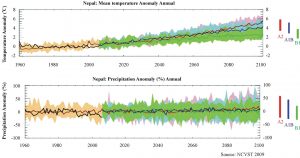The increasing political debate on climate change is unnerving. The science behind the linkage between our earth’s changing climate and human impact has been proven for years. The Intergovernmental Panel on Climate Change (IPCC) has continued to increase their certainty on this cause-effect relationship stating in their fifth assessment report in 2013 that it was “extremely likely human influence had been the dominant cause of the observed warming since the mid 20th century” (IPCC 2013). Climate models, which replicate qualities of our biosphere and the ecosystems of specific locations to predict how the climate will respond in the future. While these models cannot give us 100% certainty of what will happen to our climate in the future, they can give us a range of possible outcomes.
Upon a simple google search of climate models, websites on “skeptical science” are some of the most frequent results. This could be due to the politicization of climate change, as right wing conservatives- in the United States- continue to deny climate change as a real threat to our nation. Their propaganda is not based on science but rather skewing facts. Some people attempt to discredit the validity of climate models often due to a misunderstanding in the difference between climate and weather. A snowball in a winter season does not disprove the fact that overall global temperatures have been increasing.
While meteorologists face extreme difficulty predicting how much precipitation is going to fall in a certain area on a certain day, predictions for climate are much more broad. Climate patterns stretch across larger geographic areas and are more consistent over time, without human impact. Another important aspect of climate models, that attests to their validity, is that the systems are run multiple times and then the results are analyzed using the median as the basis for what the expected climate will be. This produces a trend that climate scientists can put some trust in.
Climate models are becoming increasingly useful in informing policy responses to the impacts of climate change, showing what changes in emissions could help decrease temperature increases globally and in location specific climate models. Regional climate models show an increase in warming overall in Nepal, but the models for precipitation show much more variation. A regional analysis of precipitation is much more helpful, especially for the people living in Nepal, who are dependent on monsoon season rains that vary greatly among the five different regions. The data that shows these precipitation changes can help inform farmers and others of what kind of variability they might expect in the long run, but it won’t be able to help them day to day, or likely even month to month.
One limitation of global climate models is that distance they account for, in some instances, is too large to account for extreme variance in geographic features. For instance, the drastic variance in elevation in Nepal gets overlooked in the GCMs as the overall area of Nepal is relatively small. Elevation changes by 8000m within 250km in Nepal, because of this GCMs that explain temperature increases, or changes in rainfall do not accurately represent what will happen to Nepal’s climate (IDS-Nepal 57).
Climate models are important for assessing climate impact as they can urge policy makers to consider the impacts of climate warming. One benefit of these models is the ways in which they are able to alter these systems to show what would happen with increasing emissions or decreasing emissions. Comparing the final models can help demonstrate just how important climate action is.
Citations:
Goverment of Nepal, and Ministry of Science, Technology and Environment. “Climate Model Data and Projections for Nepal.” Economic Impact Assessment of Climate Change in Key Sectors in Nepal, Integrated Development Society- Nepal, 2014, pp. 55–69.

